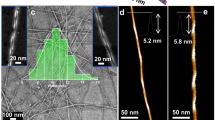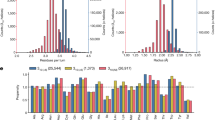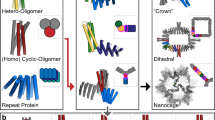Abstract
The design and construction of biomimetic self-assembling systems is a challenging yet potentially highly rewarding endeavour that contributes to the development of new biomaterials, catalysts, drug-delivery systems and tools for the manipulation of biological processes. Significant progress has been achieved by engineering self-assembling DNA-, protein- and peptide-based building units. However, the design of entirely new, completely non-natural folded architectures that resemble biopolymers (‘foldamers’) and have the ability to self-assemble into atomically precise nanostructures in aqueous conditions has proved exceptionally challenging. Here we report the modular design, formation and structural elucidation at the atomic level of a series of diverse quaternary arrangements formed by the self-assembly of short amphiphilic α-helicomimetic foldamers that bear proteinaceous side chains. We show that the final quaternary assembly can be controlled at the sequence level, which permits the programmed formation of either discrete helical bundles that contain isolated cavities or pH-responsive water-filled channels with controllable pore diameters.
This is a preview of subscription content, access via your institution
Access options
Subscribe to this journal
Receive 12 print issues and online access
$259.00 per year
only $21.58 per issue
Buy this article
- Purchase on Springer Link
- Instant access to full article PDF
Prices may be subject to local taxes which are calculated during checkout




Similar content being viewed by others
References
Zhang, F., Nangreave, J., Liu, Y. & Yan, H. Structural DNA nanotechnology: state of the art and future perspective. J. Am. Chem. Soc. 136, 11198–11211 (2014).
Lai, Y.-T., King, N. P. & Yeates, T. O. Principles for designing ordered protein assemblies. Trends Cell Biol. 22, 653–661 (2012).
King, N. P. et al. Computational design of self-assembling protein nanomaterials with atomic level accuracy. Science 336, 1171–1174 (2012).
Lai, Y.-T., Cascio, D. & Yeates, T. O. Structure of a 16-nm cage designed by using protein oligomers. Science 336, 1129 (2012).
Gradišar, H. & Jerala, R. Self-assembled bionanostructures: proteins following the lead of DNA nanostructures. J. Nanobiotechnol. 12, 4 (2014).
Lai, Y.-T. et al. Structure of a designed protein cage that self-assembles into a highly porous cube. Nature Chem. 6, 1065–1071 (2014).
King, N. P. et al. Accurate design of co-assembling multi-component protein nanomaterials. Nature 510, 103–108 (2014).
Fletcher, J. M. et al. Self-assembling cages from coiled-coil peptide modules. Science 340, 595–599 (2013).
Tebo, A. G. & Pecoraro, V. L. Artificial metalloenzymes derived from three-helix bundles. Curr. Opin. Chem. Biol. 25C, 65–70 (2015).
Gradišar, H. et al. Design of a single-chain polypeptide tetrahedron assembled from coiled-coil segments. Nature Chem. Biol. 9, 362–366 (2013).
Bromley, E. H. C., Channon, K., Moutevelis, E. & Woolfson, D. N. Peptide and protein building blocks for synthetic biology: from programming biomolecules to self-organized biomolecular systems. ACS Chem. Biol. 3, 38–50 (2008).
Gellman, S. H. Foldamers: a manifesto. Acc. Chem. Res. 31, 173–180 (1998).
Goodman, C. M., Choi, S., Shandler, S. & DeGrado, W. F. Foldamers as versatile frameworks for the design and evolution of function. Nature Chem. Biol. 3, 252–262 (2007).
Guichard, G. & Huc, I. Synthetic foldamers. Chem. Commun. 47, 5933–5941 (2011).
Johnson, L. M. & Gellman, S. H. α-Helix mimicry with α/β-peptides. Methods Enzymol. 523, 407–429 (2013).
Frackenpohl, J., Arvidsson, P. I., Schreiber, J. V. & Seebach, D. The outstanding biological stability of β- and λ-peptides toward proteolytic enzymes: an in vitro investigation with fifteen peptidases. ChemBioChem 2, 445–455 (2001).
Daniels, D. S., Petersson, E. J., Qiu, J. X. & Schepartz, A. High-resolution structure of a β-peptide bundle. J. Am. Chem. Soc. 129, 1532–1533 (2007).
Wang, P. S. P., Nguyen, J. B. & Schepartz, A. Design and high-resolution structure of a β3-peptide bundle catalyst. J. Am. Chem. Soc. 136, 6810–6813 (2014).
Pizzey, C. L. et al. Characterization of nanofibers formed by self-assembly of β-peptide oligomers using small angle X-ray scattering. J. Chem. Phys. 129, 095103 (2008).
Pomerantz, W. C. et al. Nanofibers and lyotropic liquid crystals from a class of self-assembling β-peptides. Angew. Chem. Int. Ed. 47, 1241–1244 (2008).
Horne, W. S., Price, J. L., Keck, J. L. & Gellman, S. H. Helix bundle quaternary structure from α/β-peptide foldamers. J. Am. Chem. Soc. 129, 4178–4180 (2007).
Giuliano, M. W., Horne, W. S. & Gellman, S. H. An α/β-peptide helix bundle with a pure β3-amino acid core and a distinctive quaternary structure. J. Am. Chem. Soc. 131, 9860–9861 (2009).
Burgess, K., Shin, H. & Linthicum, D. S. Solid-phase syntheses of unnatural biopolymers containing repeating urea units. Angew. Chem. Int. Ed. Engl. 34, 907–909 (1995).
Douat-Casassus, C., Pulka, K., Claudon, P. & Guichard, G. Microwave-enhanced solid-phase synthesis of N,N′-linked aliphatic oligoureas and related hybrids. Org. Lett. 14, 3130–3133 (2012).
Fischer, L. et al. The canonical helix of urea oligomers at atomic resolution: insights into folding-induced axial organization. Angew. Chem. Int. Ed. 49, 1067–1070 (2010).
Violette, A. et al. N,N′-linked oligoureas as foldamers: chain length requirements for helix formation in protic solvent investigated by circular dichroism, NMR spectroscopy, and molecular dynamics. J. Am. Chem. Soc. 127, 2156–2164 (2005).
Nelli, Y. R., Fischer, L., Collie, G. W., Kauffmann, B. & Guichard, G. Structural characterization of short hybrid urea/carbamate (U/C) foldamers: a case of partial helix unwinding. Biopolymers 100, 687–697 (2013).
Hill, R. B., Raleigh, D. P., Lombardi, A. & DeGrado, W. F. De novo design of helical bundles as models for understanding protein folding and function. Acc. Chem. Res. 33, 745–754 (2000).
Woolfson, D. N. The design of coiled-coil structures and assemblies. Adv. Protein Chem. 70, 79–112 (2005).
Fremaux, J., Fischer, L., Arbogast, T., Kauffmann, B. & Guichard, G. Condensation approach to aliphatic oligourea foldamers: helices with N-(pyrrolidin-2-ylmethyl)ureido junctions. Angew. Chem. Int. Ed. 50, 11382–11385 (2011).
Harbury, P. B., Plecs, J. J., Tidor, B., Alber, T. & Kim, P. S. High-resolution protein design with backbone freedom. Science 282, 1462–1467 (1998).
O'Shea, E. K., Klemm, J. D., Kim, P. S. & Alber, T. X-ray structure of the GCN4 leucine zipper, a two-stranded, parallel coiled coil. Science 254, 539–544 (1991).
Zaccai, N. R. et al. A de novo peptide hexamer with a mutable channel. Nature Chem. Biol. 7, 935–941 (2011).
Lear, J. D., Wasserman, Z. R. & DeGrado, W. F. Synthetic amphiphilic peptide models for protein ion channels. Science 240, 1177–1181 (1988).
Hernández, H. & Robinson, C. V. Determining the stoichiometry and interactions of macromolecular assemblies from mass spectrometry. Nature Protocols 2, 715–726 (2007).
Yadav, M. K. et al. Structure-based engineering of internal cavities in coiled-coil peptides. Biochemistry 44, 9723–9732 (2005).
Liu, R., Loll, P. J. & Eckenhoff, R. G. Structural basis for high-affinity volatile anesthetic binding in a natural 4-helix bundle protein. FASEB J. 19, 567–576 (2005).
Ghirlanda, G. et al. Volatile anesthetic modulation of oligomerization equilibria in a hexameric model peptide. FEBS Lett. 578, 140–144 (2004).
Joh, N. H. et al. De novo design of a transmembrane Zn2+-transporting four-helix bundle. Science 346, 1520–1524 (2014).
Tegoni, M., Yu, F., Bersellini, M., Penner-Hahn, J. E. & Pecoraro, V. L. Designing a functional type 2 copper center that has nitrite reductase activity within α-helical coiled coils. Proc. Natl Acad. Sci. USA 109, 21234–21239 (2012).
Faiella, M. et al. An artificial di-iron oxo-protein with phenol oxidase activity. Nature Chem. Biol. 5, 882–884 (2009).
Fremaux, J. et al. α-Peptide–oligourea chimeras: stabilization of short α-helices by non-peptide helical foldamers. Angew. Chem. Int. Ed. 34, 9816–9820 (2015).
Kabsch, W. XDS. Acta Crystallogr. 66, 125–132 (2010).
Winn, M. D. et al. Overview of the CCP4 suite and current developments. Acta Crystallogr. D 67, 235–242 (2011).
McCoy, A. J. et al. Phaser crystallographic software. J. Appl. Crystallogr. 40, 658–674 (2007).
Emsley, P., Lohkamp, B., Scott, W. G. & Cowtan, K. Features and development of Coot. Acta Crystallogr. 66, 486–501 (2010).
Murshudov, G. N. et al. REFMAC5 for the refinement of macromolecular crystal structures. Acta Crystallogr. 67, 355–367 (2011).
Delaglio, F. et al. NMRPipe: a multidimensional spectral processing system based on UNIX pipes. J. Biomol. NMR 6, 277–293 (1995).
Laskowski, R. A. SURFNET: a program for visualizing molecular surfaces, cavities, and intermolecular interactions. J. Mol. Graph. 13, 323–330 (1995).
Acknowledgements
This work was funded in part by the CNRS and Conseil Regional d'Aquitaine (Project No. 20091102003). A pre-doctoral fellowship from the University of Bordeaux (to J.F.), CIFRE support from UREkA and ANRT (to L.M.) and Marie Curie FP7-PEOPLE-2010-IEF-273224 and FP7-PEOPLE-2012-IEF-330825 postdoctoral fellowships (to K.P.-Z. and C.M.L.) are gratefully acknowledged. We thank SOLEIL synchrotron and the ERSF for providing access to synchrotron facilities (beam lines PROXIMA 1, ID23-2 and ID29), and are grateful to P. Legrand for assistance on PROXIMA 1.
Author information
Authors and Affiliations
Contributions
G.W.C. and G.G. conceived and designed the experiments. K.P.-Z., C.M.L., J.F. and L.M. synthesized and characterized the monomers and the oligomers used in this study. G.W.C. performed the crystallization experiments, collected X-ray data, solved and refined the crystal structures and performed the CD experiments. G.W.C., F.R. and V.G. designed and performed the mass spectrometry experiments. C.D.M. designed and performed the NMR spectroscopy experiments. M.D. and O.L. designed and performed the microscopy experiments. G.W.C., F.R., M.D., O.L., V.G., C.D.M. and G.G. analysed and interpreted the experimental data. G.W.C. and G.G. prepared the manuscript. All the authors reviewed and contributed to the manuscript.
Corresponding author
Ethics declarations
Competing interests
G.G. is cofounder of UREkA SARL and has financial interests in the company. The other authors declare no competing financial interests.
Supplementary information
Supplementary information
Supplementary information (PDF 4097 kb)
Supplementary information
Structure factors file for H1 (CIF 6443 kb)
Supplementary information
Crystallographic data for H1 (CIF 15 kb)
Supplementary information
Structure factors file for H2 (CIF 6412 kb)
Supplementary information
Crystallographic data for H2 (CIF 15 kb)
Supplementary information
Structure factors file for H4 (CIF 790 kb)
Supplementary information
Crystallographic data for H4 (CIF 14 kb)
Supplementary information
Structure factors file for H5 (CIF 10365 kb)
Supplementary information
Crystallographic data for H5 (CIF 16 kb)
Rights and permissions
About this article
Cite this article
Collie, G., Pulka-Ziach, K., Lombardo, C. et al. Shaping quaternary assemblies of water-soluble non-peptide helical foldamers by sequence manipulation. Nature Chem 7, 871–878 (2015). https://doi.org/10.1038/nchem.2353
Received:
Accepted:
Published:
Issue Date:
DOI: https://doi.org/10.1038/nchem.2353
This article is cited by
-
Segmentation strategy of de novo designed four-helical bundles expands protein oligomerization modalities for cell regulation
Nature Communications (2023)
-
Foldamers reveal and validate therapeutic targets associated with toxic α-synuclein self-assembly
Nature Communications (2022)
-
De novo design of discrete, stable 310-helix peptide assemblies
Nature (2022)
-
Structural analysis of cross α-helical nanotubes provides insight into the designability of filamentous peptide nanomaterials
Nature Communications (2021)
-
Proteomimetics as protein-inspired scaffolds with defined tertiary folding patterns
Nature Chemistry (2020)



